It’s been a few years since we wrote up a Hobie Mirage Kayaks buyers guide and there have been some notable revisions on certain models as well as a few additions to the range since, so it’s worth revisiting now in 2024. There’s quite a selection of models available and selecting your ideal ride is a matter of horses for courses – matching the kayak to the user, usage requirements and destinations. This guide should help to narrow your shortlist to a pinpointed winner. Lets get started with the entry level models and work our way through the range from there
Hobie Mirage Passport Series
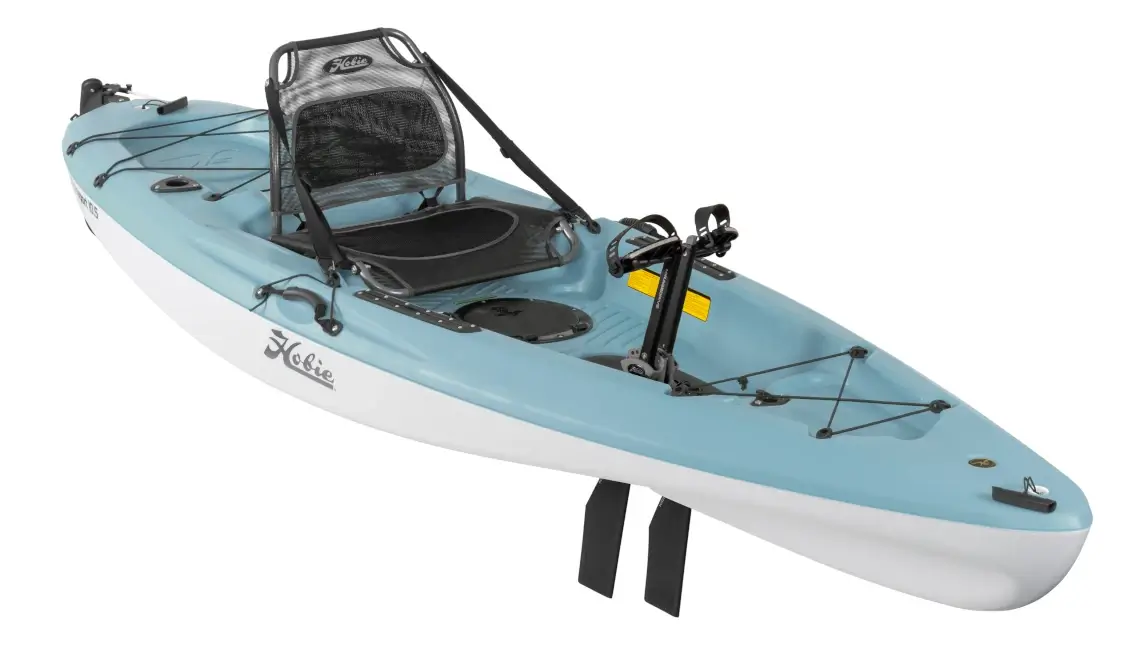
Introduced to the range in 2019, the Passport 10.5 became Hobie’s entry-level model with a significantly lower price tag than all other models. The following year Hobie introduced a 12′ Passport model, offering a bit more size, carry capacity and stability.
Currently the only Passport models available in Australia are infact 2022 models. As of 2023 Hobie stopped manufacturing these in favour of a rotomolded version of the same thing. At the time of writing these are still not available in Australia. Thermoformed models are basically the same thing, albeit built differently and in our opinion, represent better value for money and performance per-dollar. Eventually rotomolded models will become available here, although they will be significantly more expensive and on-water performance will be identical.
Of the two Passport models the 10.5 is smaller and lighter and is well suited to users that are looking for a pedal kayak that is really easy to manage off the water. The 12′ model is generally considered to be better suited as a fishing kayak, partly because it has more storage capacity and also includes a transducer scupper.
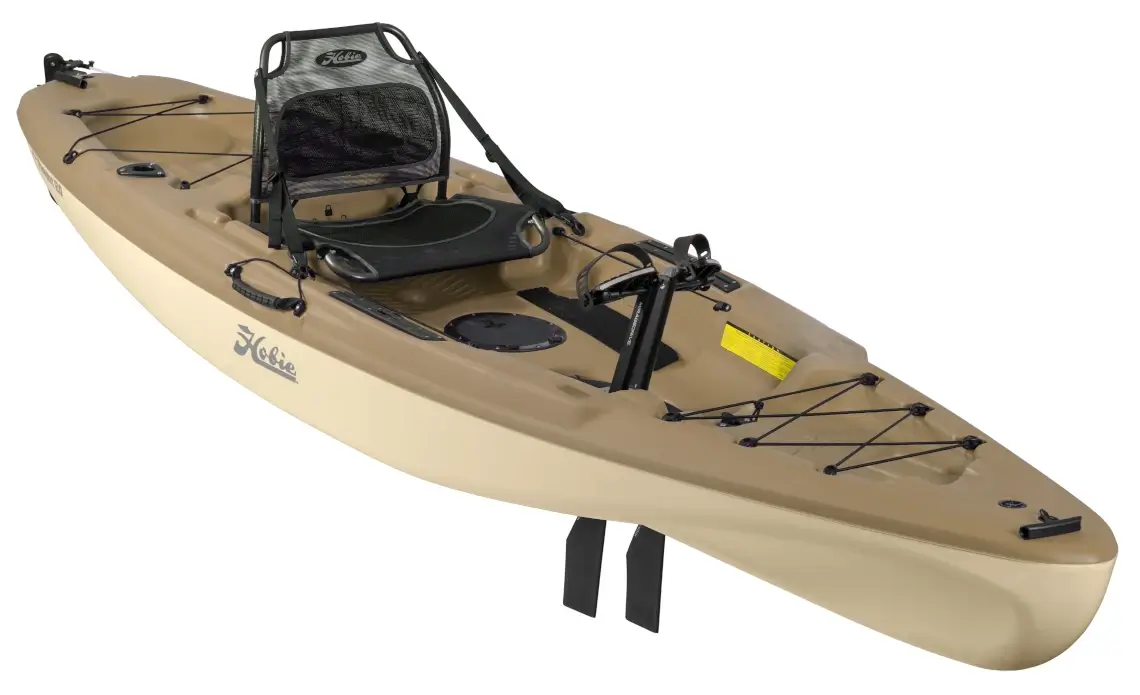
Both models are highly capable and very user-friendly kayaks, fit for use in a myriad of water conditions serving well in creeks, rivers, lakes, dams and estuaries. It’s pretty hard to go wrong with one of these really, but if you’re thinking of buying one (especially if you’re undecided between a 10.5 and a 12′ model) we’d encourage you to delve into our article that describes the Hobie Passport models in detail. Within we discuss the pros and cons of each model, and explain some of the more popular upgrades that are available
Hobie Mirage Compass Series

The Hobie Compass has been the best selling kayak here at SLH ever since it was introduced to the range back in 2018 and that is probably largely due to the fact that it is favourite among our staff. There’s a few good reasons for this but mostly because of how well it is suited for kayak fishing out in Port Phillip and Western Post Bays, both of which are on our doorstep. It’s hydrodynamic bow pierces through the water like a knife and it’s rounded chines provide excellent secondary stability, which is handy when and if it gets a bit choppy out there. In short, it performs beautifully in a wide range of conditions and circumstances, making it a terrific all-rounder.
We also appreciate the fact that it is lighter than most Hobie models of similar dimensions and we’re also fond of the simplified and highly reliable rudder steering system, comfortable seating and minimal deck layout. Although it lacks quite the same degree of mounting and storage utility of the Outback & Pro Angler models, it’s “less is more” design is still more than enough for most kayak anglers.

There are two Compass models available; one for a solo user as well as a tandem model for two occupants, fittingly named the Hobie Compass Duo. Just as we would argue that the Compass is the best all-round fishing kayak in Hobie’s range, we’d make a similar statement about the Compass Duo. The Duo was borne from popular demand following the success of the solo model and Hobie took this opportunity to use it to fill the position previously held by the Hobie Outfitter.
The Compass Duo is also superior to the Hobie Oasis in some ways, offering very similar performance but with a simplified yet equally effective rudder system, more primary stability (without sacrificing secondary stability) and gear mounting tracks on deck. There’s a bit more room to move around on deck and better storage capacity in the rear well. The Oasis is a great kayak (more on that model shortly) but the Compass Duo is simply better suited for fishing, regardless of where and how you were planning to use it.
Compared with most other Hobie models the Compass series are modestly priced and because they’re both pretty damned good at just about anything its near impossible to go wrong with them. And like all Hobie kayaks they hold their value well. If you’re thinking a Compass kayak might be a good then you’re probably right. We’ve written about these models in more detail, so our Hobie Compass Buyers Guide might be worth your time checking out.
Hobie Mirage Outback

The Hobie Outback has also always been a popular model, but the Hobie Mirage Outback has changed a lot since inception. Earlier versions of the Outback resembled the Passport 12 far more than they do current model Outbacks, which is to say it is now a very different beast.
Note our strategic use of the phrase “Beast” at the end of the previous paragraph, because that’s what this thing is. It’s a beast in that its a large kayak abundant with mounting and storage utility, and will easily and effortlessly accommodate whoever and whatever you wish to accessorize it with.
It has particularly impressive storage capability in the rear well and arguably the best mounting utility on either side of the cockpit as well. You’ll never find yourself scratching your head wondering where and how to install anything onto an Outback and you won’t need a drill (unless you’re planning to install an anchor trolley).
The Outback sits somewhere in between the Compass and the Pro Angler models and as such is an obvious choice for anyone torn between the size of the Compass and the stability & utility of the PA. In other words, the Outback is well suited for anyone planning to carry and use a fair bit of gear with enough primary stability for standing and casting (with the ability to add even more when and if required) without having to contend with the weight, bulk and price of the Pro Anglers.
The Outback hull design shares more in common with the Compass and as such as similar in performance and capability. While we give the edge to the Compass for use in potentially rougher conditions, the Outback is a steadier platform in calmer waters and would probably be a better option if you were planning to use side-scan fish finders, livewells, Power-Poles and or compete in kayak fishing tournaments.
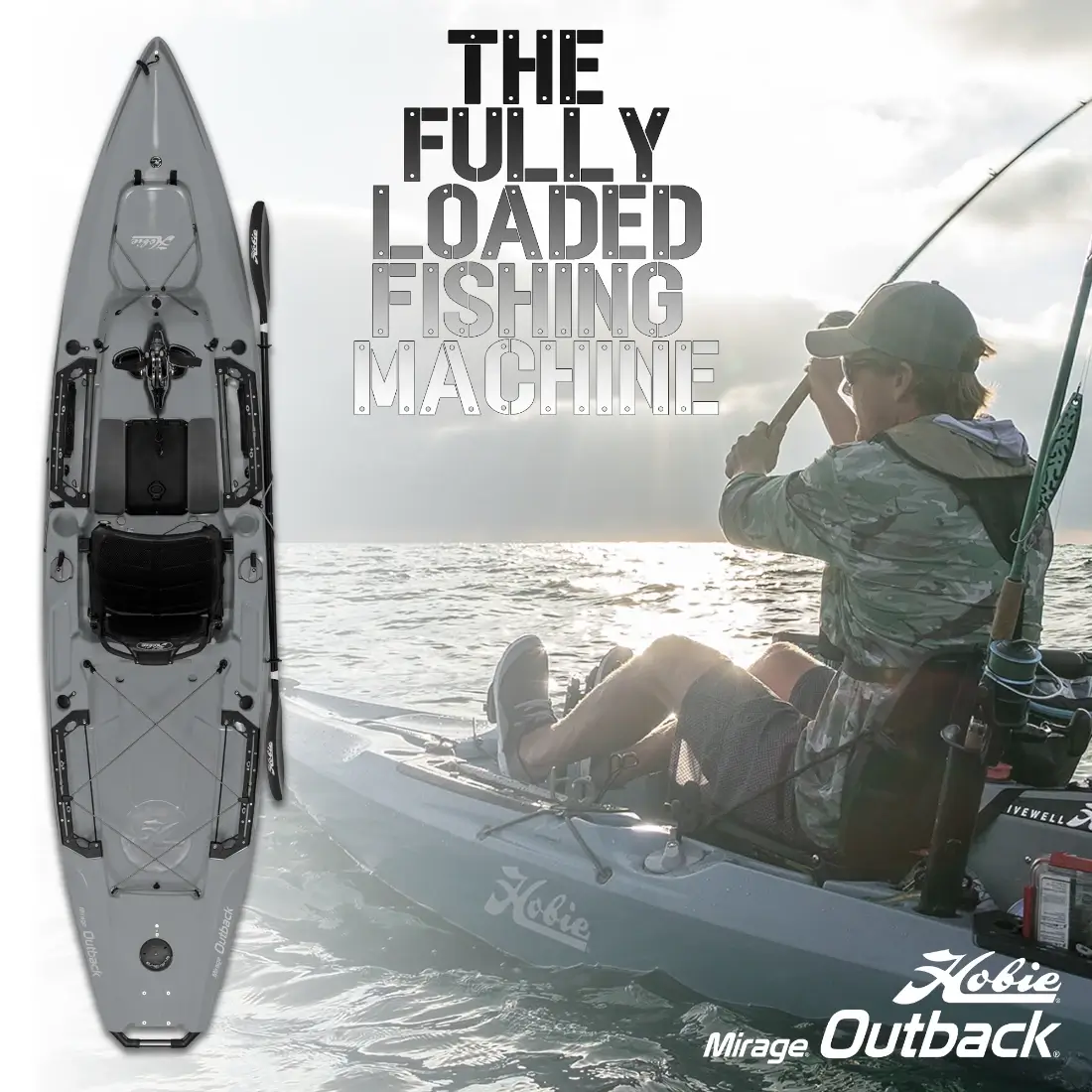
Hobie Mirage Pro Angler Series

Now that we’ve mentioned kayak fishing tournaments we segue neatly into the Pro Angler series, which also appeal to those who seek a fishing platform stable enough to stand and cast from. These have also evolved a lot through the years, although one thing that has remained consistent is their aircraft carrier like hull design. Since then Hobie have greatly improved the comfort by adding a throne for a seat, as well as Dodecagon shaped “H-Rails” that add highly versatile mounting utility.

It goes without requiring explanation that these kayaks offer the most in terms of comfort, primary stability and weight carrying capacity, and match the Outback in terms of mounting utility as well. They are also equipped with Guardian transducer scuppers, making them a great match for any side-scanning fish finder setup. Pro Anglers are ideally suited to any kayak fisho with heavy load carrying requirements with ambitions to spend big days out on the water, which is why they are so well suited for use in kayak fishing tournaments.

Currently there are 4 Pro Angler models on offer, with PA12, PA14, PA12360 & PA14360, with offerings supplied with MD180 Miragedrives as well as Pro Angler 360 variants, which are supplied with MD360 Miragedrives. The standard Pro Angler kayaks will be the best option for most users, due mainly to the significant price difference. Tournament anglers and anyone primarily fishing skinny backwaters will gain an advantage with the MD360 drive.
Obviously the standard Pro Angler kayaks are often compared with the MD360 counterparts and we’re often asked is it worth spending the extra money. The answer is always “that depends on your budget and your intended usage scenario”. Although there are advantages to 360 degree propulsion capability in certain circumstances, it’s not like any of us were struggling without it before these came along. While we can think of numerous use case scenarios, a drive like this will offer only marginal advantages in open water. Most of our customers are equally well served by the MD180 version.
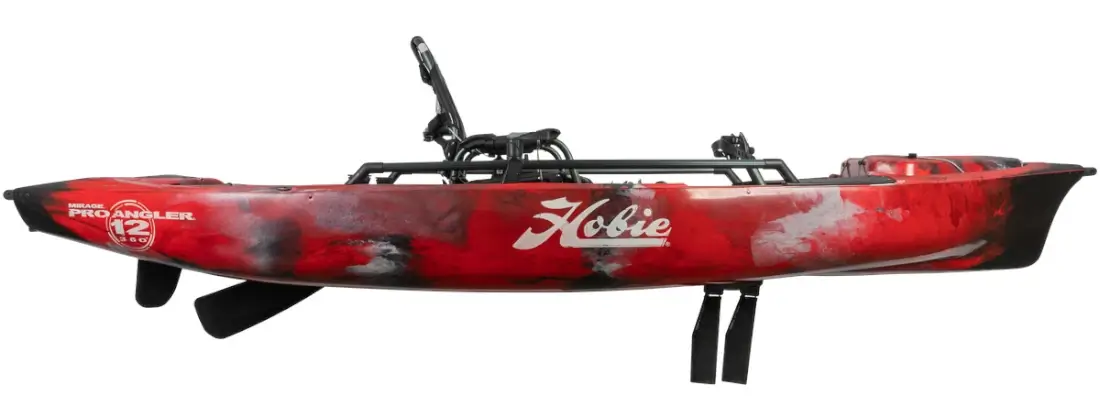
The 12′ and 14′ models are also compared and considered, to which we always recommend the bigger model for larger and heavier users, or anyone looking to load it up full of gear. While the 12′ model does have an steering performance advantage, the 14 models are a little faster, a bit more stable and carry themselves a little better is sloppy conditions.
Hobie Mirage Lynx

Whenever a customer tells us they are looking for a lightweight kayak we walk them straight over to show them the Hobie Mirage Lynx. There’s so much to like about the Lynx but most of all we just love how light it is. We’ve been lifting kayaks for years here at SLH and (most of us) are getting on in age, so it should come as no surprise that the Lynx is now our favourite model, even if only for mostly lazy and selfish reasons.
It’s not just that its so easy to move around off the water though, its also because it moves around so easily on the water as well. Due to the hull shape and weight, the Lynx sits relatively proud on the water surface with very little draft, which makes it a breeze to propel and manoeuvre. Its also incredibly stable – easily capable of standing up and stretching your legs on.
There are a few caveats to the Lynx though and the first one is obvious – it lacks storage utility and it doesn’t really have a whole lot of mounting utility either. While it does have gear tracks and optional H-Rails are available, its fair to say that the Lynx will better suit kayak anglers that embrace the “less is more” mindset.
Its also not our first choice to recommend whenever we hear a customer tells us they are planning to fish for snapper far and wide out in the bay, unless they assure us they’re not planning to do it when it gets pretty windy. While the Lynx is an excellent performer in calmer conditions, its lack of draft will work against it when the wind starts blowing and the water gets lumpy.
We should also add here that although it’s not as fragile as a surfboard, due to the hull materials these are not as durable as Hobie’s rotomolded kayaks. While there are a few workarounds for this, we do remind our Lynx customers that they need to take a little more care to avoid hard knocks.
Despite being the worst possible choice if you want to hit the surf or rapids, the Lynx is becoming very popular with a variety of user groups, including travelers that really need something that is a breeze to load and carry down to the water and back, and don’t really need to carry a stack of gear.
We’re also seeing a lot of long-time Hobie users that (like us) are also getting on in age and are looking to lighten the load and the amount of effort it takes to get down to the water, as well as getting around on the water. Its also finding a lot of fans due to it’s open deck design and high seated position, providing great visibility over the water and plenty of room on deck to stand up and even move around.
We really like the rudder system on the Lynx as well, which can easily be completely removed from the hull for storage and transit. The turning circle offered on the Lynx is incredible and we are especially fond of the fact that we can easily mount a Bixpy motor to the rudder. Seriously, getting around on a Hobie Lynx with a Bixpy electric motor attached to the rudder and a Miragedrive in front of you is next level Hobie life!
Hobie Revolution Series
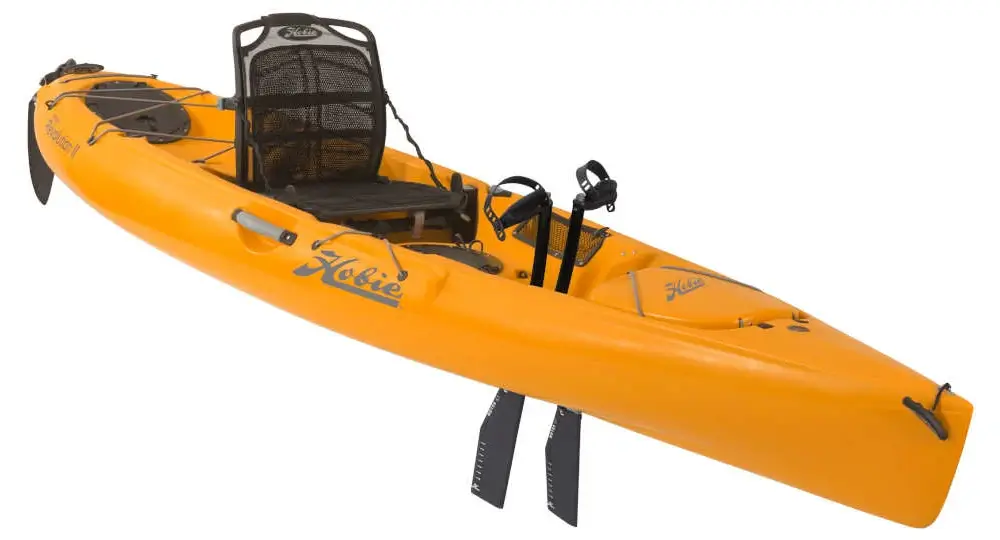
The Revolution has been present in Hobie’s range almost as long as the Outback and has always been an attractive proposition for paddlers favouring efficiency, speed and open water capability. Generally considered to be among Hobie’s best general recreational models, these are offered in 11 and 13′ models, suitably refereed to as Revo 11 and Revo 13. The former lends itself to smaller users or anyone constrained by storage or transport limitations, whereas the 13′ model is always favoured for its speed, weight capacity and stability advantages.
Their slender shape and relatively narrow beams make them glide effortlessly through the water, which makes them a popular choice for touring and kayak camping and the 13′ model in particular has found popularity among open ocean kayak anglers. Offering highly respectable pedal-powered speed and efficiency that have always appealed to anyone determined to clock up the miles.
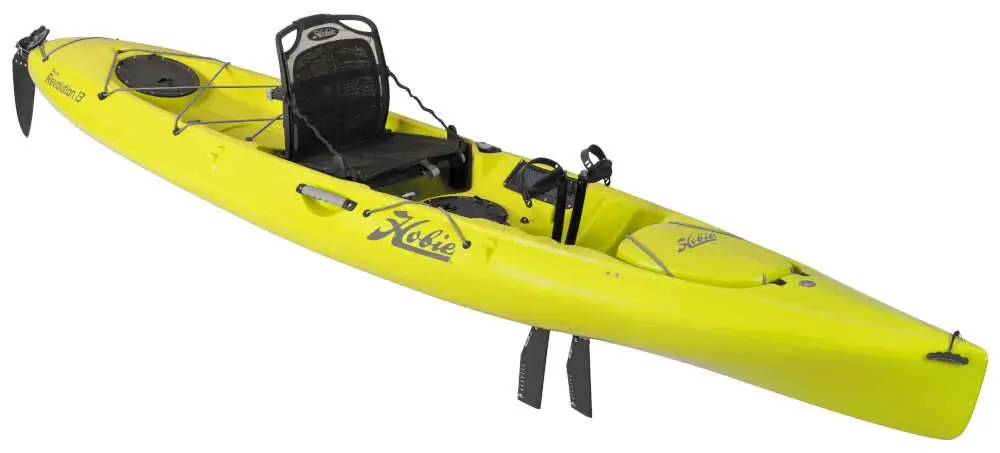
We’re not usually inclined to recommend the Revolution models as fishing kayaks as often as we used to be, however, and this is mainly due to the fact that the Compass is just a better fishing platform overall, and offers performance and capability similar to the Revolution 13.
There are quite a few niches that the Revo models fill nicely, but perhaps the most obvious one is that they are great kayaks to take on the road and travel with. Not only are they are little lighter than most other Hobie models, they’re also a little easier to man-handle, partly due to the reduced width and also because of the handle design.
And because they offer good primary stability and great secondary stability, they hold their own nicely in both calm or rougher conditions, and are highly capable in a wide variety of water conditions. This quality also makes them a great travelling companion.
Hobie Oasis
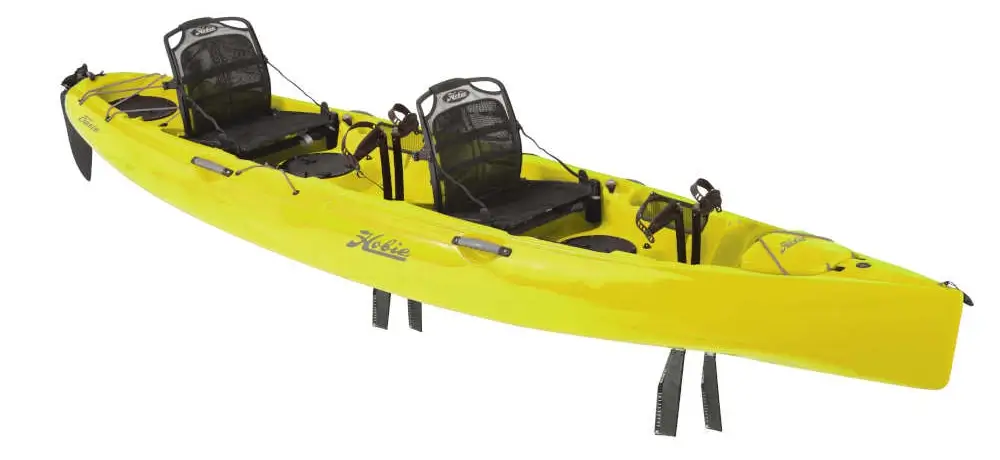
Hobie’s Tandem Oasis is essentially just a 2-person Revolution. It shares a lot of the same hull design characteristics and components, with similarly efficient performance to match. The Oasis is slightly longer and slightly thinner than the often compared Compass Duo and as such it should be ever so slightly faster. The Oasis also has a slight edge in storage utility in that it offers a storage hatch on the bow. Because of these qualities one could argue that the Oasis is a better model for kayak camping, particularly for longer expeditions.
While there are plenty of people fishing out of the Oasis kayak, the truth is that if the Compass Duo been available when they bought their Oasis, it’s likely they would have bought a Duo instead. Now that it is available the Compass Duo outsells the Oasis 10 to one and for good reasons. If it’s all about chasing fish, you’re probably better off with a Duo. While the Oasis may be fractionally faster, the Duo is a little more forgiving overall and the extra room, mounting and rear well storage capacity go a long way.
And although it’s tempting to assume that because the Oasis has adjustable seats it’s likely to be more comfortable, the seats that come with the Duo are a easier to install and are a simpler design. The although the Oasis comes with the tried and true Twist and Stow rudder system (large blade type) the kick-up rudder system on the Duo turns a little tighter, has less to go wrong and requires less maintenance.
Hobie Inflatable Kayaks
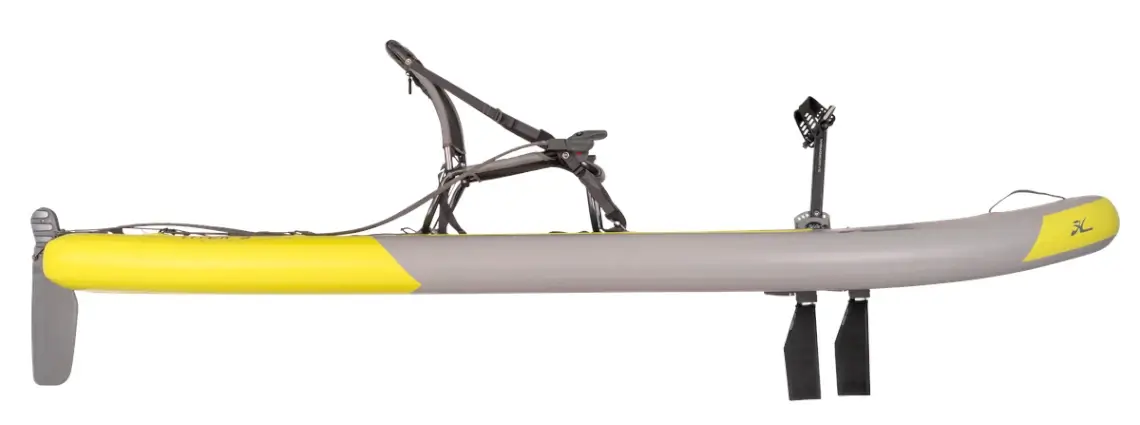
Hobie inflatable kayaks are and always have been the easiest inflatable kayak to use but current models have come along way since these were first introduced to the range. With better seats, steering systems, pedal drives and hull designs Hobie’s inflatable kayaks and lighter, more performant and easier to set up than they ever were.
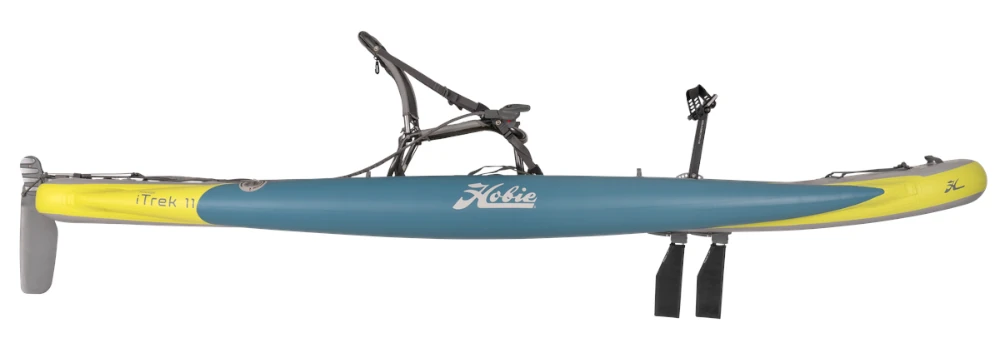
The elephant sized caveat in the room is that by virtue of being inflatable kayaks these simply will not last as long as hardbody kayaks – the inconvenient reality on inflatable products is that they have a limited lifespan. And while Hobie infloatable kayaks are durable you do need to be a little more conscientious of the fact that sharp objects can puncture them. The only real advantage inflatable kayaks offer over hard body alternatives is storage size. If you simply can’t car-top and or store a regular kayak and you really want pedal powered propulsion, then these are really the only choice.

That being the case you’ll be comforted to know that MirageDrives work wonderfully in an inflatable hull. The center line propulsion and rudder steering control ensures straight tracking, and pedaling is much simpler than paddling an inflatable kayak (which is usually a little awkward due to width and seating positions found in most inflatables). Of the inflatable models available from Hobie, the most popular model is the i-Trek 9, due largely to its reduced bulk and weight. Given that bulk and weight are two things most people interested in inflatable kayaks are looking to avoid, it’s popularity makes sense.

The i-Trek 11 is a couple foot longer and offers a little more speed, stability and weight carrying capacity. Couples seeking a tandem inflatable kayak will naturally gravitate to the iTrek 14 Duo. Then of course there is the iTrek Fiesta, which is capable of supporting up to four occupants.
Hobie Tandem Island
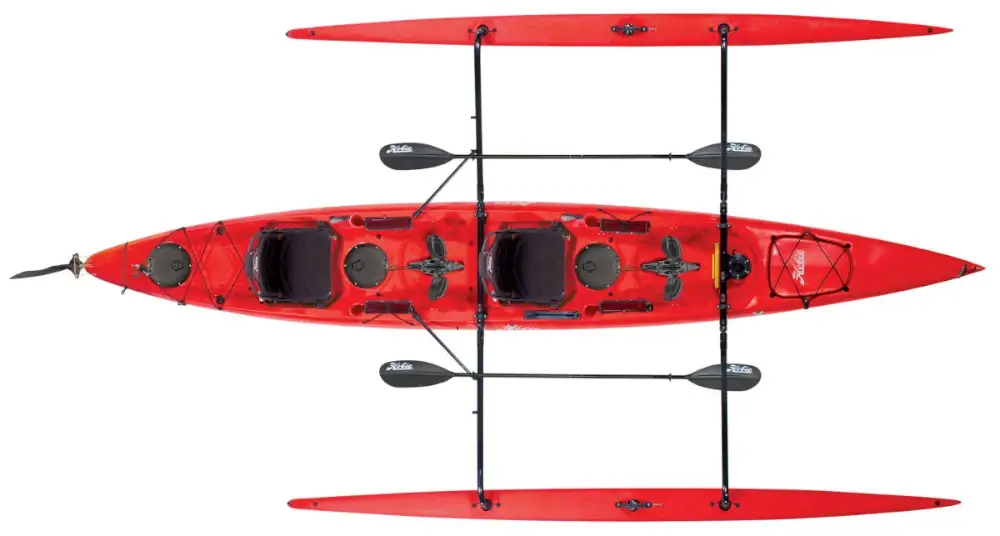
Last but certainly not least we present to you the Hobie Tandem Island, which is one of the most capable craft Hobie have ever conceived. We say “craft” instead of just “kayak” because the Tandem Island is really a small Trimaran sailing vessel that can be used as a kayak… or even as an Outrigger. Because of this versatile design the Tandem Island can be configured for optimal usage in a variety of scenarios, from windless days on millpond calm waters, to gusty conditions in a rolling swell.
Because they are so versatile and capable the Tandem Island appeals to sailing enthusiasts, adventurers, anglers as well as being a popular choice for expeditions. There’s really no comparing the Tandem Island to anything else in Hobie’s range because they are a completely different beast entirely.
They’re incredibly stable and with roller-furling sail operation are really very easy to sail as well. With a clever design that has been refined over the years, TI’s can be assembled, rigged and disassembled with ease.
Tandem Islanders can be found having the time of their lives on rivers and lakes through to bays and open ocean. They’re a whole lot of fun and they have no equal. They are rather large, however, and they come with appendages, so although they can be car-topped on roof racks, most users have an easier time of it when they transport and store it on a trailer.
